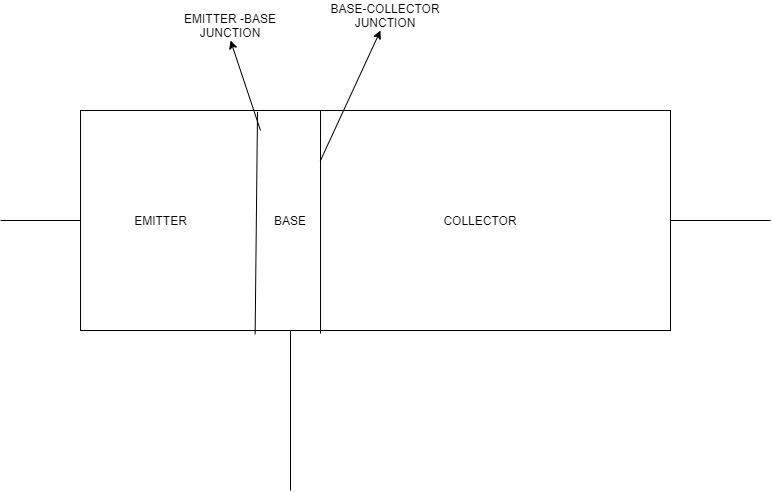
For a transistor which of the following statements are true:
(1) Base, emitter, and collector regions have similar size and doping concentrations.
(2) The base region must be very thin and lightly doped.
(3) The emitter-base junction is forward biased and the base-collector junction is reverse biased.
(4) Both the emitter-base junction as well as the base-collector junction are forward biased.
A) (4) and (1)
B) (1) and (2)
C) (2) and (3)
D) (3) and (4)
Answer
501k+ views
Hint: A transistor is a semiconductor device that is commonly used as a switch in electronic circuits and as an amplifier. It consists of three regions called Emitter, Base, and Collector. The charge-carriers originate in the Emitter region and travel across the Base to the Collector region. There are 2 P-N junctions: Emitter-Base junction and Base-Collector junction. The voltage applied to one junction causes changes in the other junction and helps control it.

Complete step by step solution:
Let us study the validity of each of the four statements with explanations:
(1) Base, emitter, and collector regions have similar size and doping concentrations.
The Emitter, Base, and Collector regions have different sizes with varying concentrations.
The order of the size of these regions are:
Base < Emitter < Collector
The order of the concentration of the regions are:
Base < Collector < Emitter
Hence, these regions are doped differently and their sizes are also not similar.
Hence, this statement is wrong.
(2) The base region must be very thin and lightly doped.
The base region is the thinnest region of the transistor and the electron concentration of this region, as a result, is the lowest among the three regions.
Hence, this statement is correct.
(3) The emitter-base junction is forward biased and the base-collector junction is reverse biased.
The emitter region has a high concentration of electrons. So, connecting them across the base will result in their movement to the base and then, the collector. To facilitate the movement of the charge carriers from the emitter, the emitter-base junction is forward biased, and the base-collector junction is reverse biased to attract these charge carriers towards the collector region.
Hence, this statement is correct.
(4) Both the emitter-base junction as well as the base-collector junction are forward biased.
If both the emitter-base and collector-base junction are forward biased, the charge carriers will not be able to cross the barrier across the base to move to the collector, thereby, decreasing or hindering the functionality of the transistor.
Hence, this statement is incorrect.
Note:
Some students might get confused in the statements whether they are referring to PNP junction transistors or NPN junction transistors. Irrespective of the type of the transistor, these statements hold because, in the NPN transistor, the electrons are the main carriers and in the PNP transistor, the holes are the main carriers. So, in either case, these statements are not ambiguous.

Complete step by step solution:
Let us study the validity of each of the four statements with explanations:
(1) Base, emitter, and collector regions have similar size and doping concentrations.
The Emitter, Base, and Collector regions have different sizes with varying concentrations.
The order of the size of these regions are:
Base < Emitter < Collector
The order of the concentration of the regions are:
Base < Collector < Emitter
Hence, these regions are doped differently and their sizes are also not similar.
Hence, this statement is wrong.
(2) The base region must be very thin and lightly doped.
The base region is the thinnest region of the transistor and the electron concentration of this region, as a result, is the lowest among the three regions.
Hence, this statement is correct.
(3) The emitter-base junction is forward biased and the base-collector junction is reverse biased.
The emitter region has a high concentration of electrons. So, connecting them across the base will result in their movement to the base and then, the collector. To facilitate the movement of the charge carriers from the emitter, the emitter-base junction is forward biased, and the base-collector junction is reverse biased to attract these charge carriers towards the collector region.
Hence, this statement is correct.
(4) Both the emitter-base junction as well as the base-collector junction are forward biased.
If both the emitter-base and collector-base junction are forward biased, the charge carriers will not be able to cross the barrier across the base to move to the collector, thereby, decreasing or hindering the functionality of the transistor.
Hence, this statement is incorrect.
Note:
Some students might get confused in the statements whether they are referring to PNP junction transistors or NPN junction transistors. Irrespective of the type of the transistor, these statements hold because, in the NPN transistor, the electrons are the main carriers and in the PNP transistor, the holes are the main carriers. So, in either case, these statements are not ambiguous.
Recently Updated Pages
Master Class 10 Science: Engaging Questions & Answers for Success

Master Class 10 Social Science: Engaging Questions & Answers for Success

Master Class 10 Maths: Engaging Questions & Answers for Success

Master Class 10 English: Engaging Questions & Answers for Success

Class 10 Question and Answer - Your Ultimate Solutions Guide

Master Class 9 General Knowledge: Engaging Questions & Answers for Success

Trending doubts
Give 10 examples of unisexual and bisexual flowers

Draw a labelled sketch of the human eye class 12 physics CBSE

Differentiate between homogeneous and heterogeneous class 12 chemistry CBSE

Differentiate between insitu conservation and exsitu class 12 biology CBSE

What are the major means of transport Explain each class 12 social science CBSE

What is the difference between resemblance and sem class 12 social science CBSE




